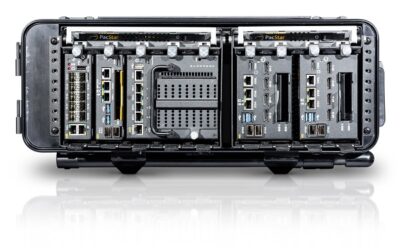Former WARPAC nations possibly a growing market for Western tactical radio suppliers
While one would not normally associate an air show with the exhibition of tactical radios, the ILA event being held in Berlin between 25 April and 29 April did not disappoint in this regard with Rockwell Collins displaying its TruNet GR-2500 two-channel manpack radio.
This transceiver covers wavebands of 118 megahertz/MHz to 400MHz, 30MHz to 450MHz, 1.2 gigahertz/GHz to 1.45GHz and 1.755GHz to 1.85MHz with 20 watts of output power offered across all of these wavebands. In fact, the GR-2500 bears a very close resemblance to the firm’s AN/PRC-162(V)1 manpack radio which is equipping the US Army, sans US encryption and waveforms. In August 2017 Rockwell Collins was awarded a contract to provide 101 AN/PRC-162(V)1 manpack radios, alongside Harris which was also contracted to deliver its AN/PRC-158 Falcon-III multichannel manpack transceiver as part of the army’s continued testing programme for its handheld, manpack, small form factor initiative with operational testing to this end continuing between 2018 and 2019.
In terms of waveforms, the AN/PRC-162(V)1 can accommodate the US SINCGARS (Single Channel Ground and Airborne Radio System) waveform operating across a 30MHz to 88MHz waveband and the US HAVEQUICK-I/II waveform operating across a waveband of 225MHz to 400MHz. This is in addition to NATO’s SATURN (Second Generation Anti-Jam Tactical UHF Radio for NATO) waveform HAVEQUICK-I/II successor covering a 225MHz to 400MHz waveband. All of these waveforms can be used for air-to-ground/ground-to-air communications, as can the US VULOS (Very/Ultra High Frequency Line-of-Sight) waveform which offers frequency-hopping rates of between 2,400 to 56,000 hops-per-second, although can also be used in a fixed frequency mode. The AN/PRC-162(V)1 is supplied bereft of these waveforms and US proprietary encryption in the guise of the GR-2500.
Sources close to Rockwell Collins state that the firm is eager to supply the GR-2500 to the European market, particularly as a replacement for legacy manpack transceivers being used across NATO’s European membership. Additional sources present at ILA close to several former Warsaw Pact (WARPAC) nations whom have now joined NATO have also expressed interest in acquiring new manpack radios to replace legacy systems currently in use, many of which are of Soviet or Russian origin, as are many of the handheld transceivers in use with these countries. Nevertheless, the sources continued that integrating Western radios into militaries thus equipped can present its own challenge in terms of interoperability. For example, integrating NATO or proprietary Western waveforms into such radios can either be technically difficult, or prohibited due to export requirements. It is noteworthy that anecdotal evidence from the Ukrainian Civil War stated that while an array of Harris transceivers outfitted with the SINCGARS waveform had been supplied to Ukrainian land forces via the provision of US non-lethal military equipment, difficulties have been experienced by the Ukrainians in integrating these radios with other communications systems used throughout their army. That said, SINCGARS has shown itself to be impressively robust against Russian jamming efforts which have characterised a significant element of that country’s involvement with the conflict since Moscow’s annexation of Crimea in March 2014. The resilience of SINCGARS-equipped radios in this regard could serve to increase demand for such transceivers, particularly from NATO nations which may perceive a tangible threat from Russian interference or intervention, such as those which share borders with the latter, despite the interoperability challenges that having a mixed fleet of Western and legacy WARPAC radios could pose. One method by which such difficulties could be surmounted could be the procurement of a finite number of NATO-compatible radios which could be used to equip those forces which might be expected to provide a deterrent effect or physical defence against Russian forces, and to also facilitate communications with other NATO forces during any combined multilateral operations. As well as being useful for conventional NATO deterrence operations in the European area, this could also afford similarly high levels of interoperability with other NATO forces so equipped during out of area operations similar to those which NATO has performed in the Afghan and Balkans theatres.

























